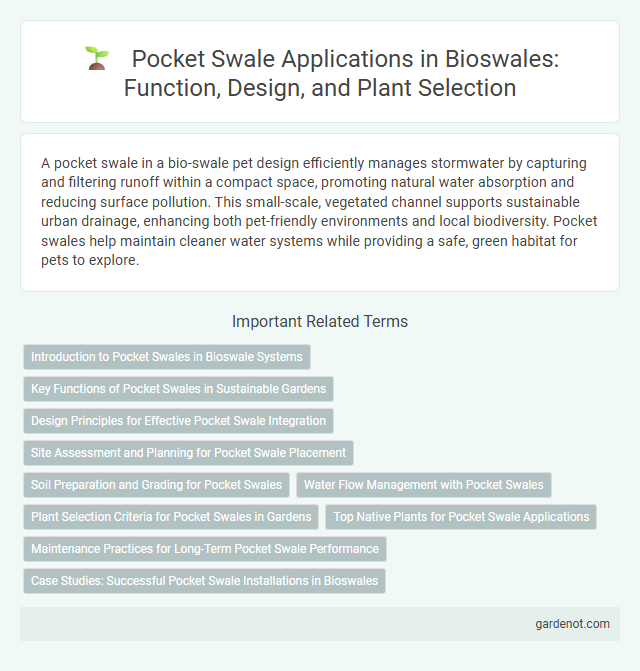A pocket swale in a bio-swale pet design efficiently manages stormwater by capturing and filtering runoff within a compact space, promoting natural water absorption and reducing surface pollution. This small-scale, vegetated channel supports sustainable urban drainage, enhancing both pet-friendly environments and local biodiversity. Pocket swales help maintain cleaner water systems while providing a safe, green habitat for pets to explore.
Introduction to Pocket Swales in Bioswale Systems
Pocket swales are compact, shallow, vegetated channels designed to capture, slow, and infiltrate stormwater runoff within bioswale systems. These structures effectively reduce surface water flow, filter pollutants, and promote groundwater recharge in urban and suburban landscapes. Incorporating pocket swales enhances water quality management while supporting sustainable, low-impact development practices.
Key Functions of Pocket Swales in Sustainable Gardens
Pocket swales efficiently manage stormwater by capturing and slowly infiltrating runoff, reducing erosion and preventing flooding in sustainable gardens. They enhance soil moisture retention, supporting diverse plant growth and improving overall garden resilience. These swales also filter pollutants from water, contributing to healthier ecosystems and promoting groundwater recharge.
Design Principles for Effective Pocket Swale Integration
Pocket swale design prioritizes efficient stormwater capture by incorporating site-specific topography to guide runoff into shallow, vegetated channels that promote infiltration and pollutant filtration. Vegetation selection emphasizes native, deep-rooted plants to stabilize soil while enhancing water absorption and providing habitat benefits. Proper spacing, slope control, and overflow mechanisms ensure functionality during heavy rainfall, minimizing erosion and maximizing groundwater recharge in urban and developed landscapes.
Site Assessment and Planning for Pocket Swale Placement
Site assessment for pocket swale placement involves evaluating soil permeability, slope gradient, and existing drainage patterns to optimize water infiltration and prevent erosion. Planning requires mapping areas with frequent runoff accumulation and selecting locations that maximize stormwater capture within limited urban spaces. Incorporating native vegetation and ensuring accessibility for maintenance enhances the effectiveness and longevity of pocket swales in managing localized water flow.
Soil Preparation and Grading for Pocket Swales
For effective soil preparation and grading in pocket swales, ensure the soil is loosened to at least 12 inches to enhance infiltration and root growth. Maintain a gentle slope, typically 1-3%, directing runoff towards the swale while preventing erosion and stagnant water accumulation. Incorporating organic matter improves soil structure and water retention, crucial for maximizing the swale's stormwater management performance.
Water Flow Management with Pocket Swales
Pocket swales efficiently manage water flow by capturing and directing runoff into small, strategically placed depressions that promote infiltration and reduce surface runoff. These compact bioswales slow water velocity, enhancing soil absorption and minimizing erosion in urban landscapes. Integrating pocket swales into stormwater management systems mitigates flooding risks and improves water quality by filtering pollutants naturally.
Plant Selection Criteria for Pocket Swales in Gardens
Plant selection for pocket swales in gardens prioritizes native species with deep root systems to enhance soil infiltration and stabilize embankments. Drought-tolerant and water-loving plants that can thrive in both saturated and dry conditions optimize water absorption and minimize erosion. Incorporating a mix of grasses, shrubs, and perennials supports biodiversity while improving the swale's ecological function.
Top Native Plants for Pocket Swale Applications
Top native plants for pocket swale applications include species such as Asclepias tuberosa (Butterfly Weed), Echinacea purpurea (Purple Coneflower), and Carex spp. (Sedges), which enhance water absorption and support local biodiversity. These plants thrive in moist, well-drained soils typical of bio-swale environments and contribute to erosion control while filtering runoff pollutants. Selecting native perennials with deep root systems optimizes soil stabilization and maximizes the ecological benefits of pocket swales.
Maintenance Practices for Long-Term Pocket Swale Performance
Regular inspection and removal of sediment buildup are essential for maintaining pocket swale efficiency, preventing waterlogging and promoting optimal infiltration. Vegetation management through periodic pruning and replanting enhances pollutant absorption and stabilizes soil structure. Implementing scheduled maintenance protocols and monitoring water flow rates ensures the long-term performance and durability of pocket swales in sustainable urban drainage systems.
Case Studies: Successful Pocket Swale Installations in Bioswales
Pocket swales have demonstrated their effectiveness in numerous case studies by significantly reducing stormwater runoff and improving groundwater recharge in urban bioswales. Projects in cities like Portland and Seattle showcase how pocket swales, integrated within green infrastructure, enhance pollutant filtration and support native plant growth. These installations consistently reduce peak flow rates and mitigate flooding risks while promoting biodiversity in heavily paved environments.
Pocket swale Infographic

 gardenot.com
gardenot.com